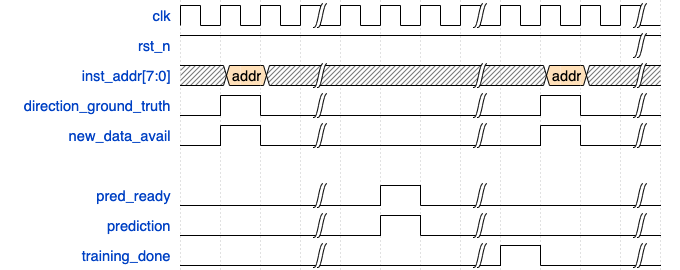704 TinyTapeout Minimal Branch Predictor
704 : TinyTapeout Minimal Branch Predictor

- Author: Tristan Robitaille
- Description: A minimal perceptron-based branch predictor
- GitHub repository
- Open in 3D viewer
- Clock: 1000000 Hz
How it works
This project implements a very minimal perceptron-based branch predictor. Using basic SPI, it reads in the lower part of the address of a branch instruction and its ground truth branch direction (taken or not taken). Due to constraints on the memory architecture (namely, 1 byte read per cycle), the prediciton is not single-cycle.
The branch predictor is based on this paper: Dynamic Branch Prediction with Perceptrons.
This project uses latch-based memory from Michael Dell, available at: tt06-memory
It's best to run this project in its Docker container.
The func_sim directory contains a C++ functional simulation of the infrastructure. It parses a log file of a simulated execution of a RISC-V reference program and predicts the branch direction on each branch instruction.
From the func_sim directory:
- Compile the reference:
riscv32-unknown-elf-gcc -O0 start.S reference.c -o reference -march=rv32i_zicsr_zifencei -T link.ld -nostartfiles -nostdlib - Disassemble reference:
riscv32-unknown-elf-objdump -d reference > reference_dis.txt(for info only) - Run Spike on reference:
spike --log=spike_log.txt --log-commits --isa=rv32i_zicsr_zifencei --priv=m -m128 reference(to generate execution log) - Make Makefile:
cmake CMakeLists.txt - Compile functional simulation:
make - Run:
./build/func_sim ./spike_log.txt
The tests directory includes all CocoTB test for this design.
Run them with make.
The documentation waveform is generated by Wavedrom.
How to test
The branch predictor reads the lowest 8b of a 32b RISC-V address on pins inst_addr, the branch direction on pin uio[1] and a pulse notifying that new data is available on pin new_data_avail.
Once the prediction is ready, it pulses pin pred_ready, pushes the prediction on pin prediction. Once training is complete, it pulses pin training_done.
You can also request the history buffer by pulsing pin history_buffer_request. On the next cycle, the branch history will be sent to pin DEBUG_history_buffer_output, one cycle at a time, starting from the most recent.
Notes:
- After rst_n goes back high, you must wait for
mem_reset_doneto pulse. This is because the branch predictor resets its own memory. If new data comes in while it is resetting its memory, an inference will not be started. - If no training is required this round,
training_donepulses at the same time aspred_ready. - If new data is sent while the predictor is training, it will be ignored and a new inference will not be started.
Prediction waveform:

Reset waveform:

To generate the instructions to use, you can either:
- Parse
func_sim/spike_log.txtwith is a log of all instructions ran for the programfunc_sim/reference.csimulated on RISC-V rv32i_zicsr_zifencei. Seefunc_sim/src/func_sim.cppto see how that's done. - Generate a new log for a program of your choice. For this, you'll need to build the Docker. Word of caution: The Dockert takes >30 min top build and weighs >24GB.
- From root, run:
docker build -t tt_brand_predictor . - Once complete, run:
docker run -it -v `pwd`:/tmp tt_brand_predictor - Move to
func_sim:cd func_sim - Compile
reference.c:riscv32-unknown-elf-gcc -O0 start.S reference.c -o reference -march=rv32i_zicsr_zifencei -T link.ld -nostartfiles -nostdlib - Optionally, view the disassembly with:
riscv32-unknown-elf-objdump -d reference > reference_dis.txt - Generate execution log with Spike:
spike --log=spike_log.txt --log-commits --isa=rv32i_zicsr_zifencei --priv=m -m128 reference
- From root, run:
- Running
func_simoutputs a list of all branch instruction and the state of important registers in the branch predictor. You can use that to check if the predicted branch outcome is correct:./build/func_sim ./spike_log.txt
External hardware
- Some way to drive 10b (Arduino, FPGA, etc.)
- Some way to read 5b (Arduino, FPGA, oscilloscope, etc.)
IO
| # | Input | Output | Bidirectional |
|---|---|---|---|
| 0 | inst_addr[0] | pred_ready | new_data_avail |
| 1 | inst_addr[1] | prediction | direction_ground_truth |
| 2 | inst_addr[2] | training_done | DEBUG_perceptron_index[0] |
| 3 | inst_addr[3] | mem_reset_done | DEBUG_perceptron_index[1] |
| 4 | inst_addr[4] | DEBUG_new_data_avail_posedge | DEBUG_perceptron_index[2] |
| 5 | inst_addr[5] | DEBUG_state_pred[0] | DEBUG_wr_en |
| 6 | inst_addr[6] | DEBUG_state_pred[1] | DEBUG_history_buffer_output |
| 7 | inst_addr[7] | DEBUG_state_rst_mem | history_buffer_request |